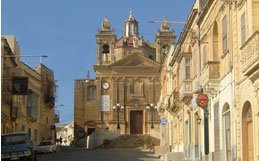| |
|
| |
 |
|
| Kercem |
| |
|
Kercem is mysteriously ancient. Although only a short distance from the Island's capital, Victoria, Kercem is a secluded village. Its origins are ancient: in fact, the village and the outlying countryside are home to several antiquities, and the source of much Gozitan folklore.
Il-Mixta, one of its hills, is the probable site of the first human settlement in the Maltese Islands 7,000 years ago. Other than that, very little is known of Kercem's beginnings and name. Even its emblem, a simple design with three circles, seems to be lost in unexplained imagery. Its motto, flectar non frangar (bent but not broken), likewise begs some kind of tribute. |
 |
|
| |
|
Until 1968, there was one day in the year when tribute did flow down Kercem road. On March 12, feast day of St. Gregory, a pilgrimage under the auspices of the diocese of Gozo left the Cathedral en route to the parish church of Kercem (Kerc rhymes with 'church', em reads like the letter M).
Kercem's yesteryears also linger at an inland tower, a windmill tower (at the border with Ghasri), and old houses displaying the oriental half-moon on their stone balconies. Earlier in time we find the catacombs of Ghar Gerduf, also known as l-Ghar tal-Mara l-Bajda (White Lady's Cave). Sightings of the woman in white, a mainstay in Gozitan folklore, are among the ghost stories associated with these burial chambers, which are among Malta's earliest hypogea.
The most romantic part of the village is Wied tal-Lunzjata, a fertile mini-valley which it shares with Rabat. At the wied's banks are natural springs such as Ghajn Tuta, which is reached via a steep incline. This is named for the mulberry tree, which is plentiful in these parts.
|
|
| |
|
|
 |
Santa Lucija is Kercem's little, and much older, sister village. It has 300 of Kercem's 1,400 people. This tiny outpost has its own defensive tower, even if in dire ruins, and its own windmill tower. The villagers take pride in the small but comely church of St. Lucy, which is introduced by an old stone cross. It was built in 1657 and served as Kercem's parish church between 1848 and 1851. It was enlarged in 1950 and three years later Guzeppi Briffa executed its fine paintings depicting the martyrdom of St. Lucy. A little celebration is organized in honour of St. Lucy in late autumn.
|
|
| |
|
|
This unlikely locale is the birthplace of Gozo's most enduring social event. Santa Lucija was the home of l-Orkestra tad-Dudi, a musical band which dominated Gozo's social life for more than a hundred years, including all of the 19th century. The dudi, with their violins, bass and cymbals, travelled all over Gozo doing graduations, weddings, and other parties at a time when this kind of entertainment was in its infancy. |
| |
|
|
|
 |









